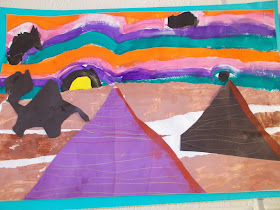2nd Graders learned all about Ancient Egypt through a short video. They learned about different Pharaohs of Ancient Egypt; like King Tut who was just a little boy when he became ruler. Ramses The Great was one of Egypt’s longest reigning pharaohs and most celebrated. He is known for building massive monuments that were far ahead of their time. There were also women Pharaohs. Hatshepsut was the first woman pharaoh, and is often considered one of the first great women in history.
Students were photographed and then transformed their photographs. Students used oil pastel and Sharpie to turn themselves into Egyptian Pharaohs. Students were required to have a heavy outlined eye, a decorative headpiece, and an Egyptian style necklace or shirt. They also created a cartouche, which is an oval with a horizontal line at one end, indicating that the text enclosed is a royal name. Students looked at an Hieroglyphic alphabet and wrote their name in hieroglyphs on metal foil.
***Lesson Idea seen on Marymaking.blogspot.com









































